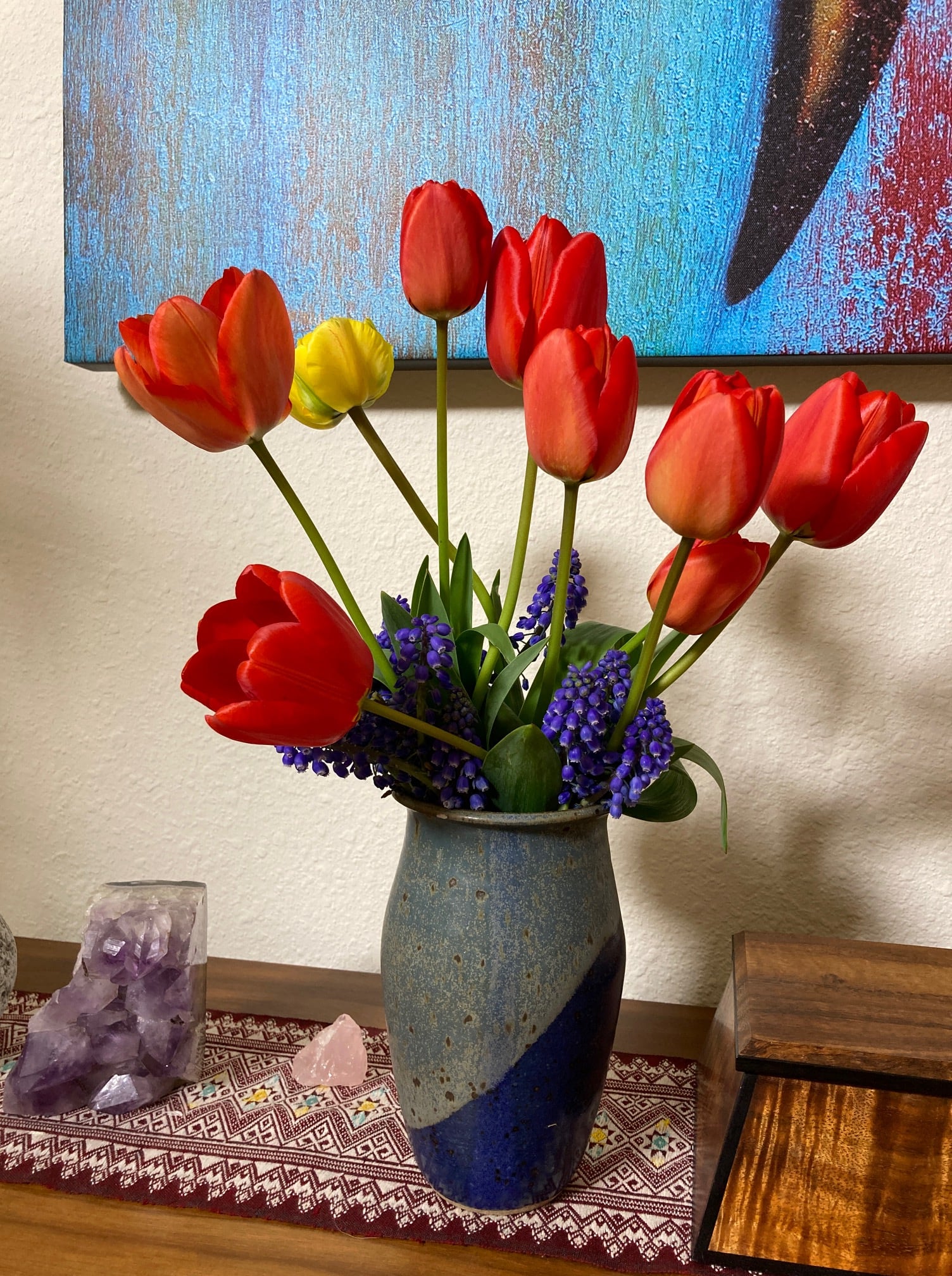I solemnly took her coat, a beautiful leather coat. A memento of sorts, the coat was something tangible to remember her by.
I claimed it as my own, a coat I’d probably never buy for myself. I still can’t imagine my mother wearing it and found no photos to prove she wore it. I must have had it in my possession for about a year after her death before I thought to actually wear it. We were headed to see a play. It was a cool Seattle autumn evening. The coat fit as if it were tailored for me.

Ma’s Leather Jacket
On our way to the car, I discovered pockets, deep pockets, to keep my hands warm. It was when I thrust my hands into ma’s deep pockets that I made my discoveries.
In the right pocket, I found a handkerchief. Perfectly clean, starched, and ironed. Instinctively, I put the hanky to my nose, as if to search out a trace of my mother’s smell. All I smelled were mothballs. Those of you reading this, who knew my mother, are laughing. I know you are, but it is no laughing matter! My mother had this thing about mothballs. Or, more accurately, she had a fear of moth infestations so she stuffed mothballs in closets, dresser drawers, coat pockets, and between our folded sweaters. My mother knew that mothballs would keep moths away. What she didn’t know was that mothballs are made of naphthalene, an insecticide, which gives off highly toxic fumes and vapors harmful to insects, wildlife, and humans.

The handkerchief
In a split second, nose to handkerchief, I was back in my childhood home. The handkerchief transported me to a small brick house in NW Indiana, where the heating and AC vents carried no-longer-secret private conversations between my parents. Conversations about their monetary worries, concerns over the safety of their children, their health, our health, our futures carried through the vents with a frightening and embarrassing clarity. I remember once confessing to a priest about eavesdropping on my parents’ private conversations. I felt that guilty so as to bring my dark shame to the confessional box! I remember the priest taking an unnatural interest in my confession! Ah, the smell of that darned handkerchief!
Back to the autumn theater night in Seattle, my fingers next touched a tube of lipstick. Ma’s coral red lipstick! My mother didn’t wear make up, but on certain rare occasions, she’d put some lipstick on. For some reason, I hardly remember this. It’s a dim memory, only brought to the surface when I found the tube of red lipstick in ma’s deep pockets.

Ma’s Coral Red Lipstick
For some reason the lipstick made me sad. I am trying to understand why it makes me sad. Maybe it’s because the lipstick is a testimony to the life my mother once lived. The tube of lipstick I found bears witness to my mother’s all-too-human life, one in which she wanted to feel more feminine, more beautiful. The tube of color to redden her lips unveils a woman, my mother, who was alive for a brief time. Holding the tube of lipstick makes me sad because I am reminded of her earthly existence, and all the complex feelings we humans may have about measuring up and concerns about how we should look and present ourselves to the world. I see her applying the red lipstick, perhaps in search of a boost of confidence and I continue to feel overwhelmed with sadness.
That same autumn evening in Seattle on our way to the theater, I found one last item, the most significant one, in ma’s deep pockets. I found my mother’s beloved saint card. I couldn’t believe I now had her treasured prayer card in my possession.

Santa Rosalia, Patron Saint of Palermo
My mother loved Santa Rosalia. Santa Rosalia is also affectionately known by Sicilians as La Santuzza, or The Little Saint. I used to see my mom pull out her saint card, covered in a clear plastic card holder. She’d lovingly caress La Santuzza, flip the card over, and I’d watch her silently lip the prayer on the card.
La Santuzza (1120-1160) is always depicted wearing a crown of roses. She is sometimes shown wearing dark thick fabrics because she cast off her riches and lived a monastic life in a cave. Her story is unusual: Rosalia was born in Palermo, Sicily, to Sicilian aristocracy (Frankish aristrocrats governing Sicily). Her father was Sinibald, Lord of Roses. Rosalia was a descendant of Charlemagne. Rosalia was a beautiful noble woman, who at a very young age, experienced a calling to devote her life to God. At age 13, she moved to a cave near the town of Santo Stephano Quisquina and devoted her life to prayer. She later moved to another cave on Mount Pellegrino, near Palermo. She lived entirely alone and died alone.

Always shown wearing a crown of roses, here La Santuzza wears the clothing of a hermit.
As a hermit, she was not venerated by her neighbors, royalty, or family. No one came to visit her. She died completely alone.
In 1625, during a period of plague, she appeared in a vision to a hunter near her cave. Her relics were discovered, brought to Palermo, and paraded through the street. Three days later the plague ended, intercession to Rosalia was credited with saving the city, and she was proclaimed its patroness. The traditional celebration of Rosalia lasted for days, involved fireworks and parades, and her feast day was made a holy day of obligation by Pope Pius XI in 1927.
Her festival is an annual celebration in Palermo, but I also found the following:
Rosalia is deeply revered as a saint to this day. Her festival is a big bash, not only in Palermo, but also in Bensonhurst (a neighborhood in Brooklyn) and other Sicilian communities. Monterey, California has a three-day fishing tournament and Italian heritage festival in her honor.
Santa Rosalia, La Santuzza, beloved saint of Palermo
My mother must have gotten the card from Sicily because La Santuzza’s prayer is in Italian. On the way home on the cold autumn evening, I dug my hands into ma’s deep pockets. Perhaps like my mother, I found myself caressing the card covered by clear plastic. I didn’t read the prayer until I got home that night.
Below is the prayer on the reverse side of La Santuzza’s card (translated from Italian to English). This is the prayer my mother lipped silently every day:
Santa Rosalia, pray to God for my family and me.
Through your powerful prayers, may we obtain health, life and salvation.
I also pray for this special need and intention
(make your intention
known).
O St. Rosalia, I promise henceforth to remember and follow your example of faith and love.
Pray for me and mine.
Amen
In Ma’s deep pockets, I discovered a cornucopia of treasures transcending time.








Fran,
I could hear your voice as I read you story. I could feel a little ache in my heart as well.
I don’t hold much value in material things but sometimes, in the smallest of things, our memories are the sweetest!
thank you for sharing this beautiful echo in your heart…
Fran, what a beautiful story. Once again, you touched my heart and made me think and feel so many things about my own earthly existence. Love, Kathy
This story makes me miss my own mom. What a treasure you received with that coat!
– Tina
Fran – I, too, admire your ability to express your memories so beautifully. A very touching evocation of your mother – and by extension “mothers and daughters” everywhere! Thank you! Cheers, Bobbie
Great story Fran. I can smell the mothballs now. Smells bring back the strongest memories. xo Susan
Amazing story, Fran. I love the interwoven memories and the sensory elements. A rich meditation on memory and faith.
Fran,
Lovely storytelling. You’re narrative is warm and arromatic like loafs of fresh baked bread emerging from the oven. Ironic how forgotten discards can evoke such treasured memories. You loved your mother very much. The bond you have with her lives large through your writing. Thanks for sharing yourself.
Love and hugs,
Michael
Fran, this inspirational piece bears witness to precious family memories. In perusing my family archives, I often dwell on how best to share and illustrate the essence of a person or memory. Your story captures that beautifully.
Thanks! Pam
Fran — if you ever stop writing your blog missives, i will, in weeks, begin to look around for something very precious i have lost, for a while not realizing what is gone, yet yearning for it just the same.
Beautiful story Fran. I enjoyed so much to read it, thank you.
What a delightful series of treasured finds! And such personal items, all there in the pockets waiting for you. Lovely!
Beautiful story, beautiful writing, Fran. Thanks for sharing.
Love, Ginger
Once again I am moved to tears, Frannie, having known Pina well and seen the card in her hand. She was a true Catholic and a born Sicilian who in her many funny ways adored her family and you.
Rick
Great stuff – made me remember that familiar moth ball smell of our childhood closets.
Dear Fran,
like all of your stiories ,I loved this one as well,beautifully written.
Love and miss you. We just talked about how sad we are that we have to miss Sicily this year. ❤️,Ursula